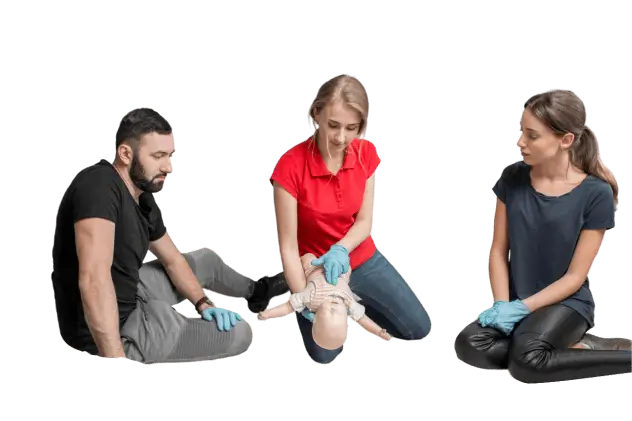- 4.0 - 8.0 CE Credit Hours
- For Pediatric Responders
- Includes Videos, Megacode Scenarios, Practice Tests & More
- FREE BLS Included
The PALS Post Arrest Shock Management Algorithm outlines the recommended steps for managing pediatric patients following spontaneous circulation (ROSC) return after cardiac arrest. It emphasizes the critical interventions necessary to stabilize the patient’s condition and optimize their chances of recovery.
The PALS Post Arrest Shock Management Algorithm addresses the critical interventions required following ROSC in pediatric patients. The flowchart below enlists steps that include assessing and maintaining adequate oxygenation and ventilation, optimizing cardiovascular function through fluid resuscitation and inotropic support, monitoring for re-arrest, and understanding the potential causes of the initial arrest to prevent recurrence. By following these steps, healthcare providers can improve the patient’s hemodynamic stability and reduce the risk of re-arrest.

Online PALS certification and recertification
- Compliant with ECC and OSHA guidelines
- Nationally accepted course
- Available anytime, anywhere
- Earn CE credit hours
$119.00
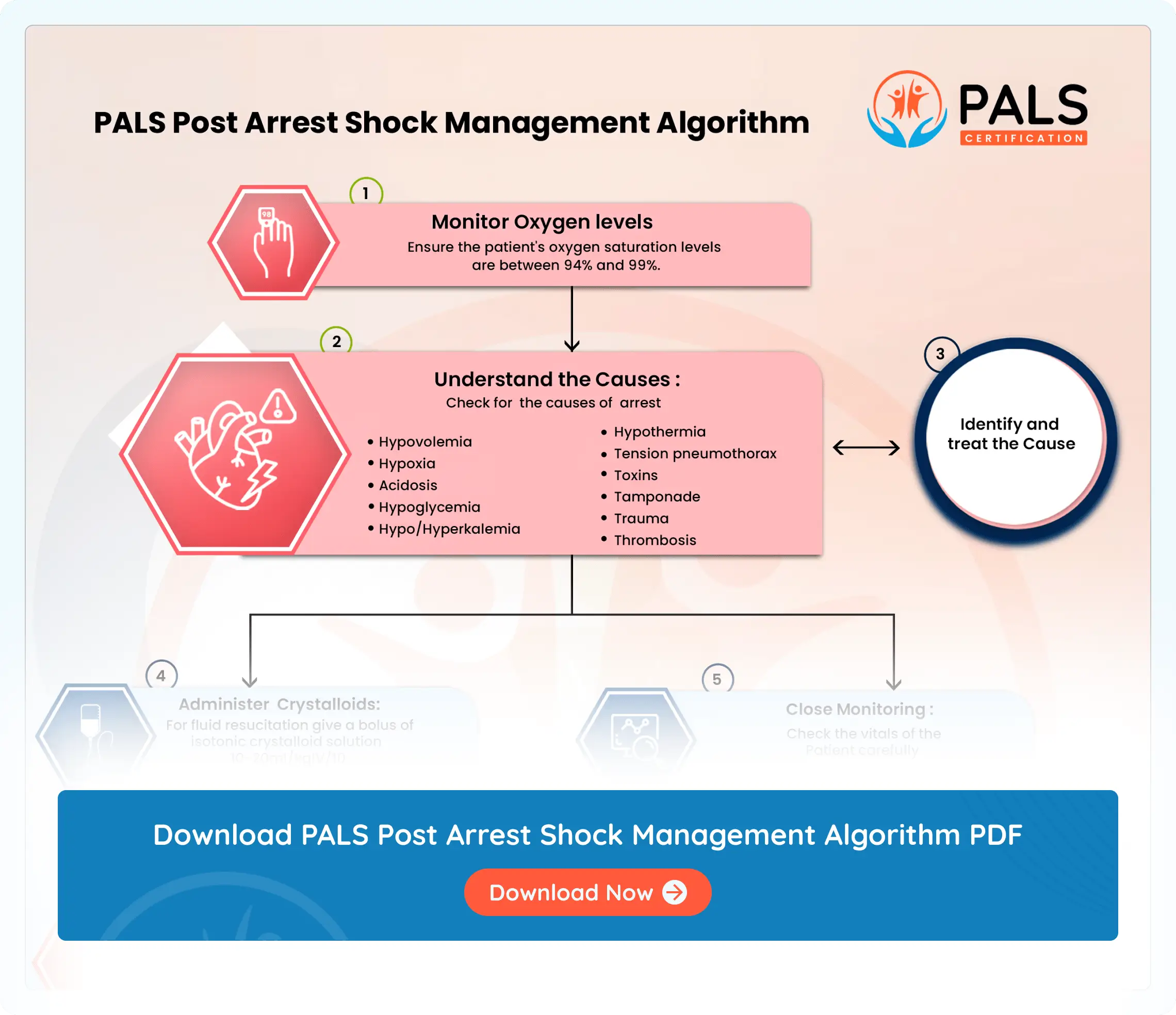
Explanation of the Flow Chart
- Maintain Oxygen Saturation 94%-99%:
- Ensure the patient’s oxygen saturation levels are between 94% and 99%.
- Identify Possible Causes using Hs and Ts:
- Consider potential underlying causes of the arrest using the Hs and T’s mnemonic:
- Hypovolemia
- Hypoxia
- Hypoglycemia
- Hypo/Hyperkalemia
- Hypothermia
- Tension pneumothorax
- Toxins
- Tamponade
- Trauma
- Thrombosis
- Treat the Cause:
- Address any identified causes promptly and appropriately.
- Bolus with Crystalloids:
- Administer a bolus of crystalloid solution for fluid resuscitation.
- Monitor Carefully:
- Continuously monitor the patient’s response and vital signs closely.
- If Hypotensive Shock:
- If the patient is in hypotensive shock, initiate Epinephrine infusion within the specified dosage range.0.1-1 mcg/kg/min
- Norepinephrine – 0.1-2mcg/kg/min
- If Not Hypotensive Shock:
- Consider other vasopressors based on clinical assessment:
- Dobutamine: 2-20 mcg/kg/min
- Norepinephrine: 0.1-2 mcg/kg/min
- Dopamine: 2-20 mcg/kg/min
- Epinephrine: 0.1-0.3 mcg/kg/min
- Monitor Blood Glucose, Level of Consciousness, and Serum Electrolytes:
- Continuously monitor critical parameters and consider transfer to a tertiary center for specialized care if needed.
- Consider Hypothermia for Unresponsive Patients:
- For out-of-hospital cardiac arrest, consider therapeutic hypothermia:
- Maintain for 5 days at 36 to 37.5°C or 2 days at 32 to 34°C, then 3 days at 36 to 37.5°C if the child remains unresponsive.
Key components of the PALS cardiac arrest algorithm include
The key components of the PALS Post Arrest Shock Management Algorithm focus on stabilizing pediatric patients following the return of spontaneous circulation (ROSC) after cardiac arrest:
- Oxygenation and Ventilation: Ensure oxygen saturation levels between 94% and 99% and maintain adequate ventilation.
- Identifying Underlying Causes: Use the Hs and T’s to identify potential causes such as hypovolemia, hypoxia, and electrolyte imbalances.
- Treating Identified Causes: Address any identified underlying causes promptly and appropriately.
- Fluid Resuscitation: Administer isotonic crystalloid boluses for fluid resuscitation to optimize intravascular volume.
- Continuous Monitoring: Vigilantly monitor vital signs, including blood pressure, heart rate, and oxygen saturation, to assess the patient’s response.
- Vasopressor Therapy: Initiate vasopressor therapy, such as Epinephrine infusion, if the patient is in hypotensive shock.
- Consideration of Alternative Vasopressors: Depending on the clinical scenario, consider alternative vasopressors like Dopamine, Norepinephrine, or Dobutamine.
- Comprehensive Monitoring and Transfer: Continuously monitor blood glucose levels, level of consciousness, arterial blood gases, and electrolytes. Transfer to a tertiary care centre if needed for specialized care.
- Therapeutic Hypothermia Consideration: Evaluate and consider therapeutic hypothermia for unresponsive patients, following specific temperature protocols to mitigate neurological damage.
Available Courses
PALS Certification and Recertification Online
ACLS Certification and Recertification Online
- 4.0 - 8.0 CE Credit Hours
- For Healthcare Professionals
- Includes Videos, Megacode Scenarios, Practice Tests & More
- FREE BLS Included
$119.00 $169.00
Get CertificateBLS Certification and Recertification Online
- 6.0 CE Credit Hours
- For Medical Fields
- Includes CPR & First Aid Bag-Mask Techniques
$36.95 $39.90
Get CertificateSource
- Importance of maintaining adequate oxygenation and ventilation during pediatric resuscitation https://www.ahajournals.org/doi/10.1161/CIRCULATIONAHA.105.166573#d3e196
- Identifying the underlying causes of pediatric arrest. https://www.ahajournals.org/doi/full/10.1161/circulationaha.110.971002
- Administering crystalloid boluses for fluid resuscitation to optimize intravascular volume. https://www.ahajournals.org/doi/full/10.1161/circulationaha.110.971002#d1e1557
- Post–Cardiac Arrest Oxygenation, blood pressure, and Ventilation Management https://www.ahajournals.org/doi/10.1161/CIR.0000000000000901
- Vasopressors for hypotensive shock https://www.ncbi.nlm.nih.gov/pmc/articles/PMC6516856/#:~:text=First%E2%80%90line%20treatment%20for%20the,epinephrine%20and%20vasopressin%20are%20recommended
- Vasoactive Drugs for Use in Post–Cardiac Arrest Patients https://www.ahajournals.org/doi/full/10.1161/circulationaha.110.971002#d1e1557
- Therapeutic Hypothermia After Cardiac Arrest https://www.ahajournals.org/doi/10.1161/CIRCULATIONAHA.111.076851
- American Heart Association: A scientific statement on Pediatric Advanced Life Support Algorithms. https://www.ahajournals.org/doi/10.1161/CIR.0000000000000697
- Pediatric cardiac arrest algorithms. AHA https://osteopathicfounders.org/wp-content/uploads/2021/01/PALS-Algorithms-2020.pdf
- The effects of graded doses of epinephrine on regional myocardial blood flow during cardiopulmonary resuscitation in swine https://www.ahajournals.org/doi/10.1161/01.CIR.75.2.491
- International Consensus on Cardiopulmonary Resuscitation and Emergency Cardiovascular Care Science With Treatment Recommendations https://www.ncbi.nlm.nih.gov/pmc/articles/PMC7576321/
- Evaluation of hospital management of pediatric out-of-hospital cardiac arrest https://www.sciencedirect.com/science/article/pii/S2666520423000760
- Experts' recommendations for the management of cardiogenic shock in children https://www.ncbi.nlm.nih.gov/pmc/articles/PMC4754230/
- PALS Post Arrest Shock Management Algorithm https://nhcps.com/lesson/pals-post-resuscitation-care-algorithm/
All PALS Algorithms
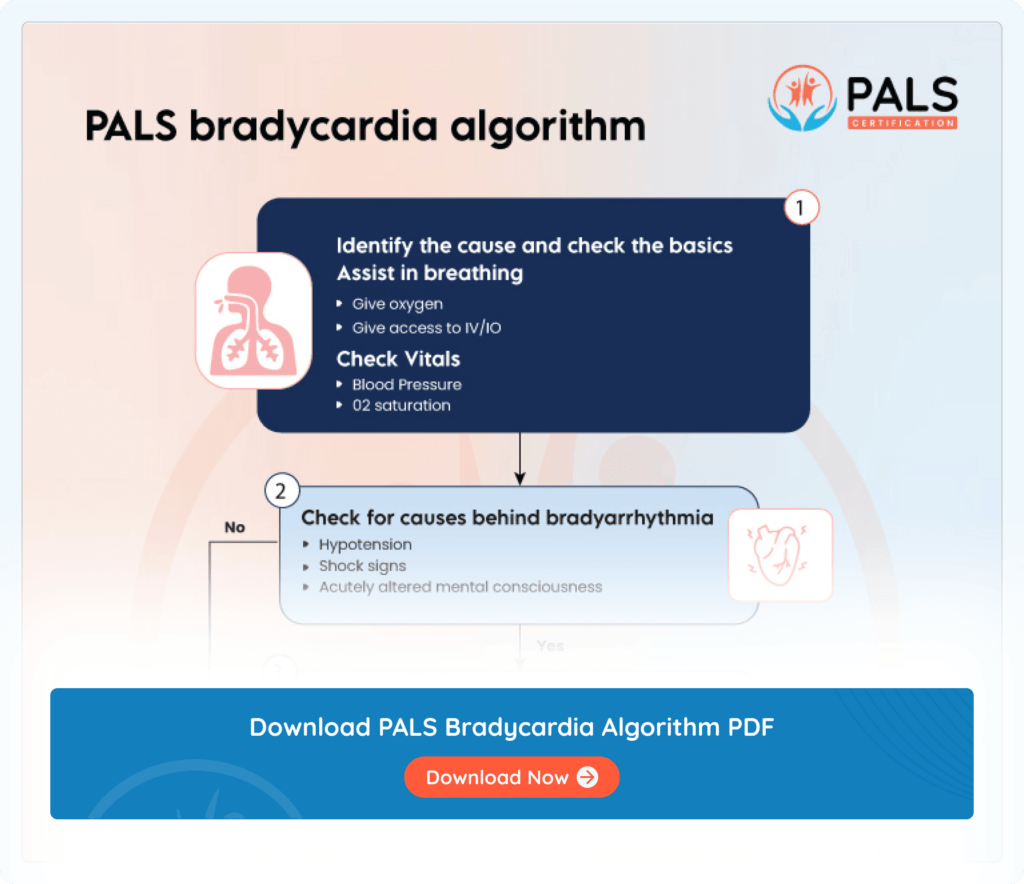
PALS Bradycardia Algorithm
The PALS Bradycardia Algorithm is a systematic approach for managing slow heart rates in pediatric patients.
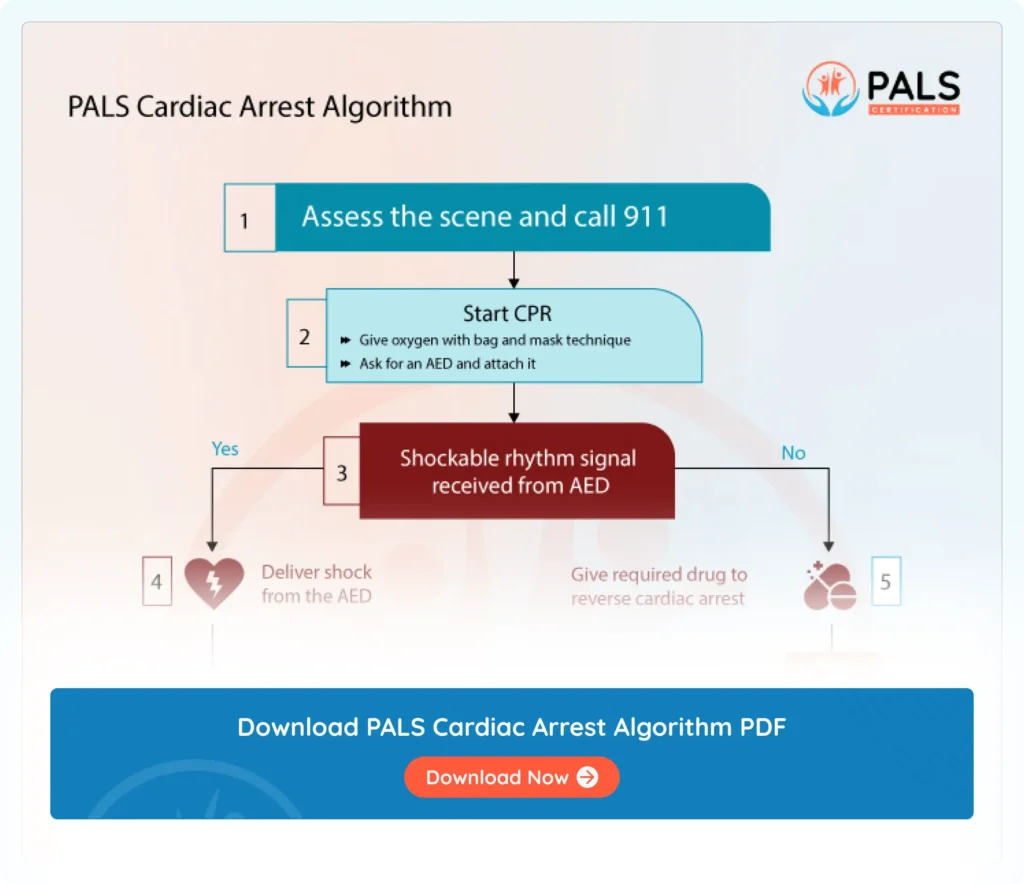
PALS Cardiac Arrest Algorithm
The PALS (Pediatric Advanced Life Support) algorithm is a standardized set of guidelines used in emergency medicine to manage pediatric cardiac arrest situations.
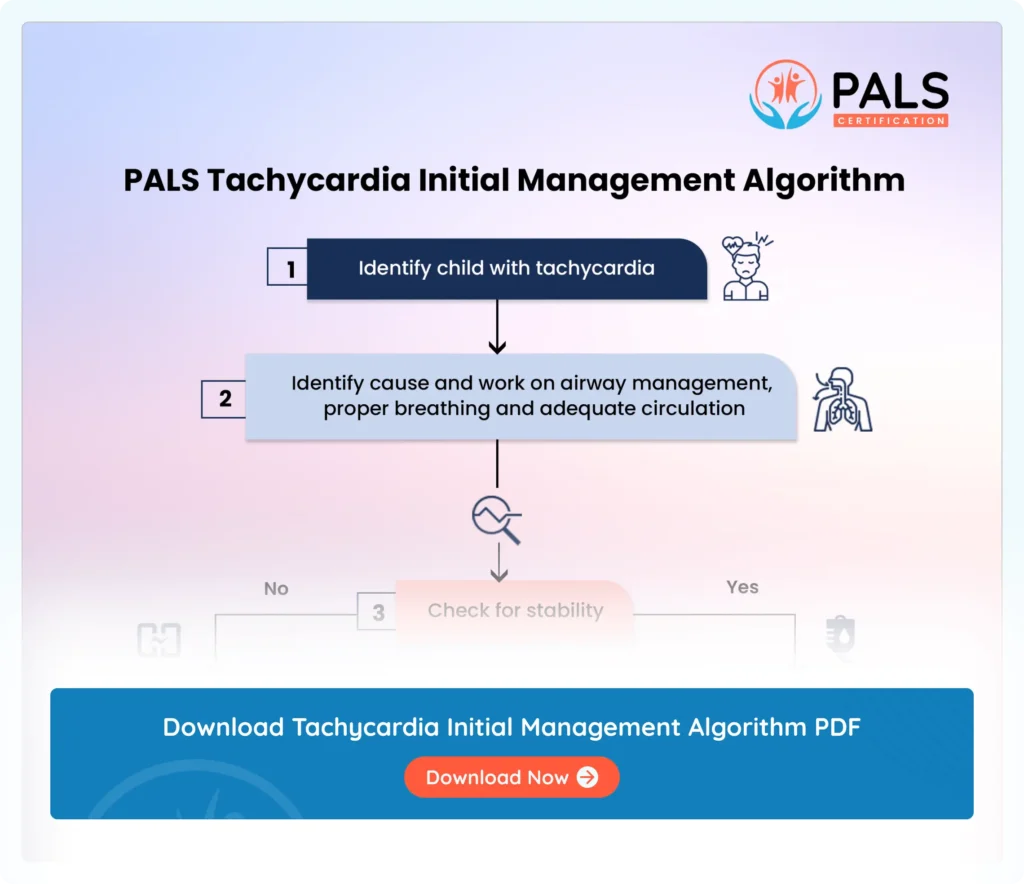
PALS Tachycardia Initial Management Algorithm
The PALS Tachycardia Initial Management Algorithm provides a systematic approach to assessing and treating pediatric tachycardia rhythms effectively.


